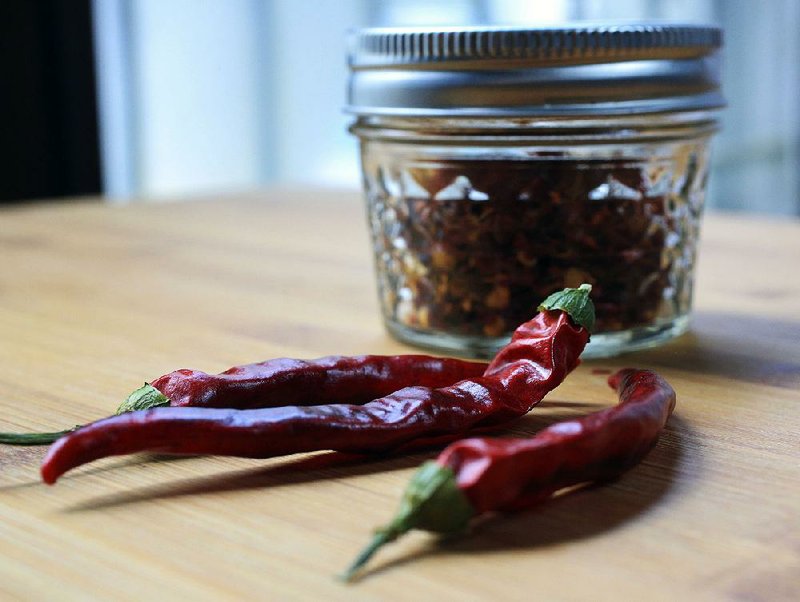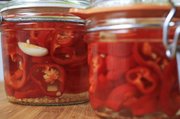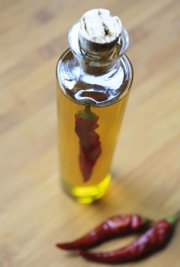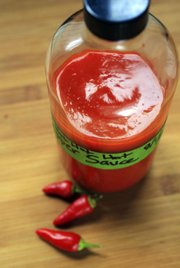My husband had a bumper crop of peppers this year.
I wouldn't go as far as saying he grew a peck, but for just three plants -- cayenne, cowhorn and Tabasco -- set out in the corner of a backyard garden, it was quite the haul. We quickly ended up with more peppers than we could eat fresh.
Cayenne and Tabasco peppers need no introduction. But you may not be familiar with cowhorns. Sometimes referred to as gentle giants, these large, long and curled peppers look fierce, but they're rather sweet with mild to medium heat.
After sampling each pepper variety's heat, we decided to dry the cayenne, sauce the Tabasco and pickle the cowhorns.
Pepper Tips
• Always wear gloves when handling chile peppers. Asthmatics and others with respiratory problems may also wish to wear a mask, especially when pureeing, grinding and working with large quantities.
• Drying peppers -- whether in the oven or using a dehydrator -- should be done in a well-ventilated area as the fumes can be pungent and irritating.
• There's no way to tell by looking how hot a pepper will be. Color is an indicator of maturity. All chiles typically start out green. As they mature and ripen they change color, often to red, but they can be orange, yellow, purple or brown.
• Removing the seeds and membranes will temper the heat, but will not remove it entirely.
• Roasting is also a great way to save peppers for future use. This method works for sweet peppers, too. To roast: Heat broiler. Arrange the peppers in a single layer on a foil-lined, broiler-safe pan. Broil, turning occasionally, until pepper skins are uniformly charred. Pull corners of foil together to tent peppers and let stand until cool enough to handle. Wearing gloves, remove and discard skins, stems, seeds and membranes. Roasted peppers will keep, covered, in the refrigerator for up to 5 days. For longer storage, freeze them between layers of butcher or parchment paper in freezer bags.
When it comes to drying peppers, the most traditional method may be tempting, but isn't necessarily practical -- stringing the peppers and leaving them to dry on a sunny wall or in the attic.
In hot, dry climates, peppers can be dried on screens left in the sun for a day or two. Unfortunately, Arkansas is much too humid and our weather is too unpredictable for this method.
Oven-drying is an easier and faster option. Simply arrange the peppers on a foil-lined baking sheet in a single layer and dry them in a 125- to 140-degree oven, rotating and turning the peppers often until the desired texture is reached.
If you don't want to tie up your oven for hours at a time, or your oven cannot be set low enough for drying, use a countertop dehydrator.
We consulted books -- The Dehydrator Bible by Jennifer MacKenzie, Jay Nutt and Don Mercer; The Beginner's Guide to Dehydrating Food by Teresa Marrone; and Preserving Everything by Leda Meredith -- and the user's manual for our dehydrator. Drying times ranged from 4 hours to 48 hours.
Each model is different, but our peppers were leathery and veering toward brittle after about 36 hours in the dehydrator.
How dry to get them depends on what you want to do with the peppers. For most purposes, the peppers should be uniformly dry and leathery with no "fleshiness" to them, but not necessarily so brittle they crumble when touched.
Store the whole dried peppers in an airtight container such as a glass jar with a tight-fitting lid or heavy-duty zip-close plastic bags. They will keep for at least a year.
To make crushed red pepper, dry the peppers until they are quite leathery and somewhat brittle. After drying, remove stems and whirl the peppers in a food processor or blender. Transfer to an airtight container and use within 6 months for best flavor.
To make ground red pepper, peppers should be dry enough that when you bend one in half it snaps. After drying, remove stems and place peppers in a spice or coffee grinder and whirl until the peppers are finely ground. The seeds will remain whole. Pass the powder through a fine sieve to remove seeds. Transfer to an airtight container and use within 6 months for best flavor.
To temper the heat of the Tabasco peppers, we added about half a pound of red bell peppers to the pepper mash. As it fermented, the mash filled our kitchen with a delectable, heady aroma of peppers and garlic.
Be sure to use a large jar, at least 1-quart, because as the pepper mash ferments, it will rise and bubble. If your jar is too small, the mash could overflow out of the jar.
Sriracha-style Hot Sauce
1 1/2 pounds red peppers such as ripe jalapenos, Fresnos or Tabascos (see note), stems removed; cut large peppers into large chunks
6 cloves garlic, peeled
4 tablespoons light brown sugar
1 tablespoon kosher salt
1/2 cup white vinegar
Cut several rounds of parchment paper to fit the jar you'll be using to ferment the mash.
Combine the peppers, garlic, sugar and salt in bowl of a food processor and pulse until peppers are finely chopped, stopping to scrape sides of bowl as necessary. Transfer mixture to a clean 1-quart or larger jar, press a round of parchment paper to the surface of the pepper mixture, cover the jar with cheesecloth and let sit at room temperature, stirring once a day for 3 to 5 days or until little bubbles start to form in the bottom of the jar. Replace the parchment rounds as needed. Once bubbles appear, ferment 2 to 3 days more, stirring once or twice a day. The mash may separate with a clear-ish liquid on the bottom and the pepper solids at the top -- this is normal. Just give it a good stir and let it continue fermenting. If you notice small dots of mold forming on the surface of the mash, simply scoop them out along with the surrounding mash and continue. If the brine turns cloudy, don't worry. This is absolutely normal as is whitish sediment in the bottom of the jar. However, if the mixture takes on a rotten or putrid odor, discard the batch and start over. Something went wrong.
Transfer mixture to jar of a blender, add the vinegar, and puree until completely smooth. Transfer to a mesh strainer set atop a medium saucepan. Strain mixture into saucepan, using a rubber spatula to push through as much pulp as possible. Discard the solids. (Or spread them in a thin layer on a rimmed baking sheet lined with parchment paper and dry in a 200-degree oven for about an hour, stirring occasionally, to make fermented crushed red pepper. Caution: Be sure your kitchen is well-ventilated if you do this. Don't do this if you have respiratory problems, as your house will fill with very strong and possibly irritating pepper fumes.)
Bring mixture to a boil, reduce heat and simmer until sauce thickens and clings to a spoon, 5 or 10 minutes. Cool. Transfer to an airtight container and store in refrigerator for up to 6 months.
Note: We used a combination of Tabasco and red bell peppers.
Recipe adapted from Serious Eats and Fiery Ferments by Kirsten K. Shockey and Christopher Shockey
Quick Pickled Peppers
2 cups sliced peppers
¾ cup distilled vinegar
¾ cup water
1 to 3 tablespoons sugar
1 tablespoon kosher salt
1 to 2 cloves garlic, peeled
Slice the peppers and place in a clean jar (or jars) with a tight-fitting lid.
In a small saucepan, combine the vinegar, water, sugar, salt and garlic. Bring to a boil over medium heat, stirring to dissolve sugar and salt.
Pour brine over the peppers in the jar. Cool to room temperature.
Cover tightly and refrigerate for about a week before using. Use within a few months.
Makes about 2 cups.
I also made chile oil with the dried cayenne peppers. It is important to follow the instructions very carefully. Anaerobic bacteria, such as the kind that cause botulism, thrive in oxygen-free environments.
"The fresh vegetables, herbs, and/or fruits used to flavor or infuse oils can be contaminated with C. bot [Clostridium botulinum] spores. Fresh produce also contains water, which allows bacteria such as C. bot to live and grow. C. bot thrives in an oxygen-free environment like oil. This is why flavored and infused oils must be made and stored correctly to prevent botulism poisoning," according to The University of Maine Cooperative Extension Bulletin No. 4385, "Safe Homemade Flavored and Infused Oils."
It is vital to use dried peppers in the following recipe.
Chile Oil
1/2 cup olive oil
1 dried chile pepper (see note)
Wash and sanitize a small glass jar or bottle by submerging it in boiling water for 30 seconds. Remove jar or bottle from water and air dry. The jar must be completely dry. (I used a hair dryer to ensure my jar was thoroughly dry inside.)
In a small saucepan over low heat, warm the oil to 180 degrees.
Place the pepper in the dry, sanitized bottle. Pour the warmed oil over the pepper, add cap and cool.
Store oil in a cool, dark place and use within 3 months.
Note: To keep the pepper from floating, remove the stem or pierce the pepper in a couple of places to release any air.
Method from University of Maine Cooperative Extension
Food on 08/15/2018



